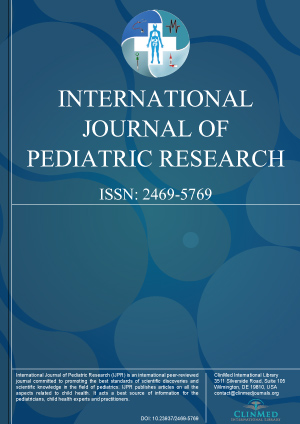Open Access DOI:10.23937/2469-5769/1510072
The Usefulness of High Sensitivity C-Reactive Protein (hs- CRP) to Differentiate between Severe and Non-Severe Dengue in Children
Aaradhana, Bineeta Kashyap, Krishna Singhla and Rahul Sharma
Article Type: Original Research | First Published: December 31, 2020
High sensitivity CRP (Hs-CRP) has not been studied in children with dengue so far. We conducted this descriptive cross-sectional study to compare hs-CRP levels between a group of 31 children under 12 year of age with dengue (positive NS1 antigen and/IgM ELISA for dengue) and healthy comparison group and between severe and non-severe dengue cases. Hs-CRP levels were assessed in sera of hospitalized dengue cases and healthy controls. Median (IQR) hs-CRP levels were 46.59 (34.8, 67.0) mg/L and 0.53...
Open Access DOI:10.23937/2469-5769/1510071
Novel Technique of Wire-Guided Retrograde Esophageal Dilatation in Infants Using Feeding Tubes: The “DRIFT” Technique
Ravi Patcharu, MS, MCh, Karunesh Chand, MS, MCh and Badal Parikh, MD
Article Type: Research Article | First Published: November 05, 2020
Esophageal dilatation is the modality of choice for managing anastomotic stricture after primary repair of esophageal atresia (EA). Balloon dilatation over guide wire is the preferred technique with minimal chances of mucosal erosion. In some cases of tight strictures, safe antegrade dilatation becomes impossible if the guidewire cannot be negotiated across the stricture. In such situations, retrograde dilatation is a safer alternative to avoid another thoracotomy for stricture resection and ana...
Open Access DOI:10.23937/2469-5769/1510070
Our Experience Treatment Inhalation Injury in Children in Uzbekistan
Babur M Shakirov, PhD and Noila Ashurova, MD
Article Type: Research Article | First Published: October 23, 2020
Thermal inhalation injury is one of the factors aggravating the course of burn disease and resulting in patient’s death. According to literary data, damage to respiratory tract occurs approximately in 30% of cases with severe burn injury. Thermal inhalation injury severity can be determined not so much by airway burns but by toxic inhalation damage to the lungs and whole body with high toxic gaseous and vaporized chemical components of smoke. During a 3 year period 28 children with deep burns ...
Open Access DOI:10.23937/2469-5769/1510069
Highly Sensitive Cardiac Troponin T as a Biomarker of Myocardial Injury in Acyanotic Congenital Heart Disease
Rishika Das, RN Mandal, Anurag Agarwal, Sumod Kurian and Bhawna Mahajan
Article Type: Original Article | First Published: October 14, 2020
An observational cross sectional study was conducted at a tertiary care center over a period of one year (April 2017 to March 2018). Stable children with ACHD aged between 6 months to 5 years were selected as cases and age matched children without ACHD as controls. Echocardiography was done in all the patients with clinical findings of ACHD. A total of 83 children (55 cases and 28 controls) were enrolled. The severity of the ACHD was determined by the defect size and the pressure gradient across...
Open Access DOI:10.23937/2469-5769/1510068
Results in Neurodevelopment after Open Cardiac Surgery in Pediatric Patients
Adriana Nieto-Sanjuanero, Arturo Alejandro García-Ramírez, Ramón Gerardo Sánchez-Cortés, Joshua Rodrigo De la O-Vega, Arturo Gerardo Garza-Alatorre and Manuel Enrique De la O-Cavazos
Article Type: Original Article | First Published: October 03, 2020
Heart diseases are considered among the most frequent congenital malformations; they have a great impact on pediatric morbidity and mortality. Children with congenital heart disease present motor and neurocognitive deficits, as well as specific functions such as attention and executive functions can be affected. It is an observational, analytical, retrospective, and cohort study, in which 10 postoperative cardiac surgery patients with the use of an extracorporeal pump were recruited regardless o...
Open Access DOI:10.23937/2469-5769/1510067
Cronobacter sakazakii in Infant Food Contamination and Its Survival Strategies in Hostile Conditions
Gedif Meseret Abebe
Article Type: Review Article | First Published: August 08, 2020
Cronobacter sakazakii is an opportunistic foodborne pathogen that causes diseases like meningitis, necrotizing enterocolitis, and bacteremia in immunocompromised, low weight individuals, neonates, infants, and elders. Cronobacter sakazakii has the ability to persist in extremely dried foods such as powdered infant formula (PIF). Infant food contamination by this bacterium is attributed to biofilm which are microbial communities attached to biotic or abiotic surfaces using a self-produced matrix ...
Open Access DOI:10.23937/2469-5769/1510066
Hypoglycemia in Exclusively Breastfed High-Risk Neonates - A Hospital-Based Study
Parth Patel, Palash R Gogoi, Santanu Deb, Prasenjit Paul, Sabrina Yesmin, Lima Sangla Jamir and Pramod Paharia
Article Type: Original Research | First Published: July 16, 2020
Hypoglycemia is one of the commonest metabolic problems in contemporary neonatal medicine. In the majority of healthy neonates, the frequently observed low blood glucose concentrations are not related to any significant problem and merely reflect normal processes of metabolic adaptation to extrauterine life. However, when low blood glucose levels are prolonged or recurrent, they may result in acute systemic effects and may result in neurologic sequelae....
Open Access DOI:10.23937/2469-5769/1510065
Cutis Laxa Syndrome
Chaima Rherib, Fatima Jabourik and Abdelali Bentahila
Article Type: Image Article | First Published: July 15, 2020
18-months-old girl, the child of related parents, with no particular pathological history, presented with respiratory disorders associated with the fever and cough. On The clinical examination, the child was febrile and had respiratory distress. The respiratory rate was 60/ min, heart rate 100/min, and blood pressure 100/70 mmHg, The weight and height were 10 kg (under 2DS) and 70 cm (normal for that age) respectively the facies was particularly suggestive of cutis laxa: An early senile appearan...

